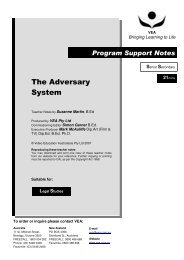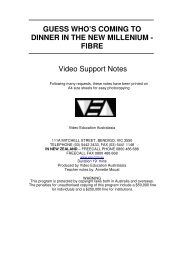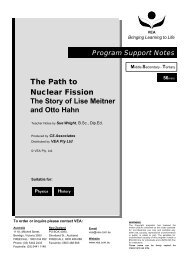Create successful ePaper yourself
Turn your PDF publications into a flip-book with our unique Google optimized e-Paper software.
Australia<br />
111A, Mitchell Street,<br />
Bendigo, Victoria 3550<br />
FREECALL: 1800 034 282<br />
Phone: (03) 5442 2433<br />
Facsimile: (03) 5441 1148<br />
<strong>Bohr's</strong> <strong>Model</strong><br />
<strong>of</strong> <strong>the</strong> <strong>Atom</strong><br />
Teacher Notes by Peter Gribben, B.Ed, B.Sc Hon,<br />
Post Graduate Certificate <strong>of</strong> Education<br />
Produced by <strong>VEA</strong> Pty Ltd<br />
Commissioning Editor Christine Henderson B.Sc.<br />
Ph.D. Dip.Ed.<br />
Executive Producer Mark McAuliffe Dip.Art (Film &<br />
TV) Dip.Ed. B.Ed. Ph.D.<br />
© <strong>VEA</strong> Pty. Ltd.<br />
Suitable for:<br />
Chemistry<br />
To order or inquire please contact <strong>VEA</strong>:<br />
New Zealand<br />
PO BOX 4390,<br />
Shortland St., Auckland<br />
FREECALL: 0800 486 688<br />
Facsimile: 0800 488 668<br />
E-mail<br />
vea@vea.com.au<br />
Website<br />
www.vea.com.au<br />
<strong>VEA</strong><br />
Bringing Learning to Life<br />
Program Support Notes<br />
Middle - Senior Secondary<br />
26mins<br />
WARNING<br />
The Copyright proprietor has licensed <strong>the</strong><br />
motion picture contained on this video cassette<br />
for non-<strong>the</strong>atrical use only and prohibits any<br />
o<strong>the</strong>r use, copying, reproduction or performance<br />
in public, in whole or part. The penalties for<br />
unauthorised copying <strong>of</strong> this program include a<br />
$50,000 fine for individuals and a $250,000 fine<br />
for institutions.<br />
These notes can be freely copied for<br />
classroom use only.
For Teachers:<br />
Introduction<br />
<strong>Bohr's</strong> <strong>Model</strong> <strong>of</strong> <strong>the</strong> <strong>Atom</strong><br />
This program is aimed at Years 11 and 12 Chemistry students; some sections may be relevant to more<br />
able Year 10 students.<br />
The program deals with how <strong>the</strong>ories about <strong>the</strong> atom have developed. It looks at <strong>the</strong> ideas <strong>of</strong><br />
Democritus, an ancient Greek philosopher, <strong>the</strong>n those <strong>of</strong> Dalton, JJ Thompson, Ru<strong>the</strong>rford and Bohr.<br />
Niels Bohr’s life and work are outlined, showing how he came up with his atomic model. The<br />
advantages and shortcomings <strong>of</strong> <strong>the</strong> Bohr model are examined.<br />
One sequence that could be used is:<br />
• check what students know before <strong>the</strong>y view <strong>the</strong> program,<br />
• alert <strong>the</strong>m to key words/terms<br />
• watch <strong>the</strong> program, making notes on key terms<br />
• discuss what is seen<br />
• give out questions<br />
• answer as many questions as possible<br />
• watch program again, filling in missing answers/correcting<br />
• go over student responses, correcting and filling in missed items.<br />
<strong>DVD</strong> Timeline<br />
00:00:00 Introduction<br />
00:01:28 Historical Developments in <strong>Atom</strong> Theories<br />
00:06:09 Summary<br />
00:07:02 A Brief Outline <strong>of</strong> Bohr’s Life<br />
00:10:13 Summary<br />
00:10:58 Bohr’s <strong>Model</strong> in Detail 1<br />
00:15:44 Summary<br />
00:16:30 Bohr’s <strong>Model</strong> in Detail 2<br />
00:19:57 Summary<br />
00:20:40 Beyond Bohr<br />
00:23:22 Summary<br />
00:24:09 Conclusion<br />
00:25:36 End credits<br />
00:26:15 Program end<br />
O<strong>the</strong>r Relevant Programs Available from <strong>VEA</strong><br />
Corrosion Chemistry<br />
Acids and Bases<br />
<strong>Atom</strong>s and Molecules - Physical Science in Action Series<br />
<strong>Atom</strong>ic Structure - Science Bank Series 2<br />
The Good, <strong>the</strong> Bad & Beyond <strong>the</strong> <strong>Atom</strong> - Part 5 - Nobel's Greatest Hits Series<br />
Please visit our website for many more relevant programs www.vea.com.au<br />
<strong>VEA</strong> – Bringing Learning to Life<br />
2
Student Worksheet:<br />
Before Viewing <strong>the</strong> Program<br />
<strong>Bohr's</strong> <strong>Model</strong> <strong>of</strong> <strong>the</strong> <strong>Atom</strong><br />
Spend a few moments thinking about your knowledge <strong>of</strong> atoms and atomic <strong>the</strong>ory. Then answer <strong>the</strong><br />
following questions<br />
1. What is meant by a “particle”?<br />
_______________________________________________________________________________<br />
_______________________________________________________________________________<br />
2. What is an atom?<br />
_______________________________________________________________________________<br />
_______________________________________________________________________________<br />
3. What is “matter”?<br />
_______________________________________________________________________________<br />
_______________________________________________________________________________<br />
4. Name three particles that make up atoms.<br />
_______________________________________________________________________________<br />
_______________________________________________________________________________<br />
5. Name two famous scientists who had <strong>the</strong>ories about atoms.<br />
_______________________________________________________________________________<br />
_______________________________________________________________________________<br />
3
While Viewing <strong>the</strong> Program<br />
<strong>Bohr's</strong> <strong>Model</strong> <strong>of</strong> <strong>the</strong> <strong>Atom</strong><br />
Have a pen/pencil and paper ready. Consider <strong>the</strong> following terms:<br />
Democritus, Dalton, atom, Thomson, Ru<strong>the</strong>rford, orbit, spectrum, Bohr, nuclear, alpha particle,<br />
electron, proton, random, kinetic energy, shell, valence, ground state, excited, quantum, photon, emit,<br />
As <strong>the</strong> program plays, as <strong>the</strong>se terms occur, jot down a quick thought about <strong>the</strong>m.<br />
1. Democritus ____________________________________________________________________<br />
_______________________________________________________________________________<br />
2. Dalton ________________________________________________________________________<br />
_______________________________________________________________________________<br />
3. atom __________________________________________________________________________<br />
_______________________________________________________________________________<br />
4. Thomson ______________________________________________________________________<br />
_______________________________________________________________________________<br />
5. Ru<strong>the</strong>rford ____________________________________________________________________<br />
_______________________________________________________________________________<br />
6. orbit __________________________________________________________________________<br />
_______________________________________________________________________________<br />
7. spectrum ______________________________________________________________________<br />
_______________________________________________________________________________<br />
8. Bohr __________________________________________________________________________<br />
_______________________________________________________________________________<br />
9. nuclear ________________________________________________________________________<br />
_______________________________________________________________________________<br />
10. alpha particle __________________________________________________________________<br />
_______________________________________________________________________________<br />
11. electron ________________________________________________________________________<br />
_______________________________________________________________________________<br />
12. proton ________________________________________________________________________<br />
_______________________________________________________________________________<br />
13. random ________________________________________________________________________<br />
_______________________________________________________________________________<br />
4
<strong>Bohr's</strong> <strong>Model</strong> <strong>of</strong> <strong>the</strong> <strong>Atom</strong><br />
14. kinetic energy __________________________________________________________________<br />
_______________________________________________________________________________<br />
15. shell __________________________________________________________________________<br />
_______________________________________________________________________________<br />
16. valence ________________________________________________________________________<br />
_______________________________________________________________________________<br />
17. ground state ____________________________________________________________________<br />
_______________________________________________________________________________<br />
18. excited ________________________________________________________________________<br />
_______________________________________________________________________________<br />
19. quantum ______________________________________________________________________<br />
_______________________________________________________________________________<br />
20. photon ________________________________________________________________________<br />
_______________________________________________________________________________<br />
21. emit __________________________________________________________________________<br />
_______________________________________________________________________________<br />
5
After Viewing <strong>the</strong> Program<br />
<strong>Bohr's</strong> <strong>Model</strong> <strong>of</strong> <strong>the</strong> <strong>Atom</strong><br />
1. Give <strong>the</strong> name <strong>of</strong> <strong>the</strong> person who first came up with <strong>the</strong> term “atom”.<br />
_______________________________________________________________________________<br />
2. What is <strong>the</strong> meaning <strong>of</strong> <strong>the</strong> Greek term “atomos”?<br />
_______________________________________________________________________________<br />
3. What is <strong>the</strong> electrical charge on electrons?<br />
_______________________________________________________________________________<br />
4. Who came up with <strong>the</strong> “plum pudding” model <strong>of</strong> <strong>the</strong> atom?<br />
_______________________________________________________________________________<br />
5. What is <strong>the</strong> electrical charge on <strong>the</strong> nucleus?<br />
_______________________________________________________________________________<br />
6. What is ano<strong>the</strong>r name for <strong>the</strong> orbits <strong>of</strong> electrons described by Bohr?<br />
_______________________________________________________________________________<br />
7. Ernest Ru<strong>the</strong>rford thought that atoms were mainly composed <strong>of</strong> what?<br />
_______________________________________________________________________________<br />
8. Which type <strong>of</strong> particles did Ru<strong>the</strong>rford fire at gold foil?<br />
_______________________________________________________________________________<br />
9. What is <strong>the</strong> “ground state” when referring to atoms?<br />
_______________________________________________________________________________<br />
10. Which electrons control <strong>the</strong> chemical behaviour <strong>of</strong> an atom?<br />
_______________________________________________________________________________<br />
11. What is <strong>the</strong> maximum number or electrons in <strong>the</strong> outer shell <strong>of</strong> an atom?<br />
_______________________________________________________________________________<br />
12. What is a “quantum”?<br />
_______________________________________________________________________________<br />
13. What is <strong>the</strong> name <strong>of</strong> <strong>the</strong> range <strong>of</strong> colours emitted by a heated atom?<br />
_______________________________________________________________________________<br />
6
<strong>Bohr's</strong> <strong>Model</strong> <strong>of</strong> <strong>the</strong> <strong>Atom</strong><br />
True/ False response worksheet - Circle <strong>the</strong> correct answer<br />
1. Bohr was <strong>the</strong> first person to come up with a model for <strong>the</strong> atom.<br />
True / False<br />
2. Dalton said that atoms could be broken into smaller pieces.<br />
True / False<br />
3. JJ Thomson came up with <strong>the</strong> “plum pudding” model <strong>of</strong> <strong>the</strong> atom.<br />
True / False<br />
4. JJ Thomson came up with a nuclear model <strong>of</strong> <strong>the</strong> atom.<br />
True / False<br />
5. Bohr analysed <strong>the</strong> spectral lines <strong>of</strong> hydrogen.<br />
True / False<br />
6. Bohr was born in Sweden.<br />
True / False<br />
7. The atomic number <strong>of</strong> an element determines its position in <strong>the</strong> Periodic Table.<br />
True / False<br />
8. The Ru<strong>the</strong>rford model <strong>of</strong> <strong>the</strong> atom had electrons moving around <strong>the</strong> nucleus in fixed orbits.<br />
True / False<br />
9. The element hydrogen has <strong>the</strong> simplest spectrum <strong>of</strong> any element.<br />
True / False<br />
10. Electrons fill up shells <strong>of</strong> an atom in a random order.<br />
True / False<br />
11. Electrons that have received energy and move into higher energy levels are “excited”.<br />
True / False<br />
12. The Bohr model is only accurate with <strong>the</strong> hydrogen atom.<br />
True / False<br />
13. Schrödinger suggested that when electrons orbit a nucleus, <strong>the</strong>y can behave like waves.<br />
True / False<br />
14. The Bohr model has been used as a basis for more sophisticated models <strong>of</strong> atom.<br />
True / False<br />
15. Schrödinger came up with <strong>the</strong> <strong>the</strong>ory <strong>of</strong> electrons being in subshells.<br />
True / False<br />
7
Suggested Student Responses<br />
Before Viewing <strong>the</strong> Program<br />
<strong>Bohr's</strong> <strong>Model</strong> <strong>of</strong> <strong>the</strong> <strong>Atom</strong><br />
Check “pre -knowledge” <strong>of</strong> students before viewing program.<br />
1. What is meant by a “particle”?<br />
Small piece/bit <strong>of</strong> something.<br />
2. What is an atom?<br />
Smallest part <strong>of</strong> an element<br />
3. What is “matter”?<br />
Anything that has mass and takes up space.<br />
4. Name three particles that make up atoms.<br />
Proton, electron and neutron.<br />
5. Name two famous scientists who had <strong>the</strong>ories about atoms.<br />
Dalton, Thomson, Ru<strong>the</strong>rford, Bohr, Schrödinger.<br />
8
After Viewing <strong>the</strong> Program<br />
<strong>Bohr's</strong> <strong>Model</strong> <strong>of</strong> <strong>the</strong> <strong>Atom</strong><br />
1. Give <strong>the</strong> name <strong>of</strong> <strong>the</strong> person who first came up with <strong>the</strong> term “atom”.<br />
Democritus<br />
2. What is <strong>the</strong> meaning <strong>of</strong> <strong>the</strong> Greek term “atomos”?<br />
Indivisible<br />
3. What is <strong>the</strong> electrical charge on electrons?<br />
Negative<br />
4. Who came up with <strong>the</strong> “plum pudding” model <strong>of</strong> <strong>the</strong> atom?<br />
JJ Thomson<br />
5. What is <strong>the</strong> electrical charge on <strong>the</strong> nucleus?<br />
Positive<br />
6. What is ano<strong>the</strong>r name for <strong>the</strong> orbits <strong>of</strong> electrons described by Bohr?<br />
Shells<br />
7. Ernest Ru<strong>the</strong>rford thought that atoms were mainly composed <strong>of</strong> what?<br />
Empty space<br />
8. Which type <strong>of</strong> particles did Ru<strong>the</strong>rford fire at gold foil?<br />
Alpha<br />
9. What is <strong>the</strong> “ground state” when referring to atoms?<br />
Lowest stable energy state<br />
10. Which electrons control <strong>the</strong> chemical behaviour <strong>of</strong> an atom?<br />
Outer/valence<br />
11. What is <strong>the</strong> maximum number or electrons in <strong>the</strong> outer shell <strong>of</strong> an atom?<br />
2 for H, He, 8 o<strong>the</strong>rs.<br />
12. What is a “quantum”?<br />
(Smallest) unit <strong>of</strong> energy<br />
13. What is <strong>the</strong> name <strong>of</strong> <strong>the</strong> range <strong>of</strong> colours emitted by a heated atom?<br />
Spectrum<br />
9
True false response worksheet<br />
<strong>Bohr's</strong> <strong>Model</strong> <strong>of</strong> <strong>the</strong> <strong>Atom</strong><br />
1. Bohr was <strong>the</strong> first person to come up with a model for <strong>the</strong> atom.<br />
False<br />
2. Dalton said that atoms could be broken into smaller pieces.<br />
False<br />
3. JJ Thomson came up with <strong>the</strong> “plum pudding” model <strong>of</strong> <strong>the</strong> atom.<br />
False<br />
4. JJ Thomson came up with a nuclear model <strong>of</strong> <strong>the</strong> atom.<br />
False<br />
5. Bohr analysed <strong>the</strong> spectral lines <strong>of</strong> hydrogen.<br />
True<br />
6. Bohr was born in Sweden.<br />
False<br />
7. The atomic number <strong>of</strong> an element determines its position in <strong>the</strong> Periodic Table.<br />
True<br />
8. The Ru<strong>the</strong>rford model <strong>of</strong> <strong>the</strong> atom had electrons moving around <strong>the</strong> nucleus in fixed orbits.<br />
False<br />
9. The element hydrogen has <strong>the</strong> simplest spectrum <strong>of</strong> any element.<br />
True<br />
10. Electrons fill up shells <strong>of</strong> an atom in a random order.<br />
False<br />
11. Electrons that have received energy and move into higher energy levels are “excited”.<br />
True<br />
12. The Bohr model is only accurate with <strong>the</strong> hydrogen atom.<br />
True<br />
13. Schrödinger suggested that when electrons orbit a nucleus, <strong>the</strong>y can behave like waves.<br />
True<br />
14. The Bohr model has been used a basis for more sophisticated models <strong>of</strong> atom<br />
True<br />
15. Schrödinger came up with <strong>the</strong> <strong>the</strong>ory <strong>of</strong> electrons being in subshells.<br />
True<br />
10










